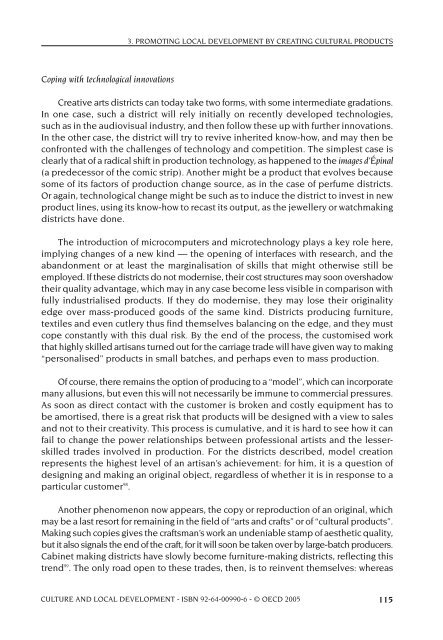OECD Culture and Local Development.pdf - PACA
OECD Culture and Local Development.pdf - PACA
OECD Culture and Local Development.pdf - PACA
Create successful ePaper yourself
Turn your PDF publications into a flip-book with our unique Google optimized e-Paper software.
3. PROMOTING LOCAL DEVELOPMENT BY CREATING CULTURAL PRODUCTS<br />
Coping with technological innovations<br />
Creative arts districts can today take two forms, with some intermediate gradations.<br />
In one case, such a district will rely initially on recently developed technologies,<br />
such as in the audiovisual industry, <strong>and</strong> then follow these up with further innovations.<br />
In the other case, the district will try to revive inherited know-how, <strong>and</strong> may then be<br />
confronted with the challenges of technology <strong>and</strong> competition. The simplest case is<br />
clearly that of a radical shift in production technology, as happened to the images d’Épinal<br />
(a predecessor of the comic strip). Another might be a product that evolves because<br />
some of its factors of production change source, as in the case of perfume districts.<br />
Or again, technological change might be such as to induce the district to invest in new<br />
product lines, using its know-how to recast its output, as the jewellery or watchmaking<br />
districts have done.<br />
The introduction of microcomputers <strong>and</strong> microtechnology plays a key role here,<br />
implying changes of a new kind — the opening of interfaces with research, <strong>and</strong> the<br />
ab<strong>and</strong>onment or at least the marginalisation of skills that might otherwise still be<br />
employed. If these districts do not modernise, their cost structures may soon overshadow<br />
their quality advantage, which may in any case become less visible in comparison with<br />
fully industrialised products. If they do modernise, they may lose their originality<br />
edge over mass-produced goods of the same kind. Districts producing furniture,<br />
textiles <strong>and</strong> even cutlery thus find themselves balancing on the edge, <strong>and</strong> they must<br />
cope constantly with this dual risk. By the end of the process, the customised work<br />
that highly skilled artisans turned out for the carriage trade will have given way to making<br />
“personalised” products in small batches, <strong>and</strong> perhaps even to mass production.<br />
Of course, there remains the option of producing to a “model”, which can incorporate<br />
many allusions, but even this will not necessarily be immune to commercial pressures.<br />
As soon as direct contact with the customer is broken <strong>and</strong> costly equipment has to<br />
be amortised, there is a great risk that products will be designed with a view to sales<br />
<strong>and</strong> not to their creativity. This process is cumulative, <strong>and</strong> it is hard to see how it can<br />
fail to change the power relationships between professional artists <strong>and</strong> the lesserskilled<br />
trades involved in production. For the districts described, model creation<br />
represents the highest level of an artisan’s achievement: for him, it is a question of<br />
designing <strong>and</strong> making an original object, regardless of whether it is in response to a<br />
particular customer 98 .<br />
Another phenomenon now appears, the copy or reproduction of an original, which<br />
may be a last resort for remaining in the field of “arts <strong>and</strong> crafts” or of “cultural products”.<br />
Making such copies gives the craftsman’s work an undeniable stamp of aesthetic quality,<br />
but it also signals the end of the craft, for it will soon be taken over by large-batch producers.<br />
Cabinet making districts have slowly become furniture-making districts, reflecting this<br />
trend 99 . The only road open to these trades, then, is to reinvent themselves: whereas<br />
CULTURE AND LOCAL DEVELOPMENT - ISBN 92-64-00990-6 - © <strong>OECD</strong> 2005 115














